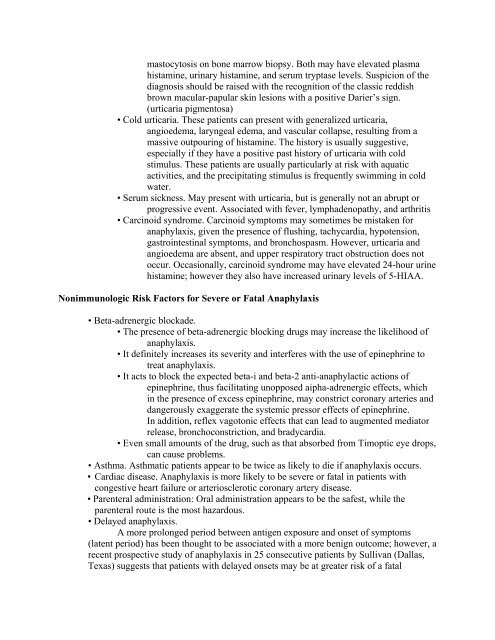Immunotherapy Safety for the Primary Care ... - U.S. Coast Guard
Immunotherapy Safety for the Primary Care ... - U.S. Coast Guard
Immunotherapy Safety for the Primary Care ... - U.S. Coast Guard
Create successful ePaper yourself
Turn your PDF publications into a flip-book with our unique Google optimized e-Paper software.
mastocytosis on bone marrow biopsy. Both may have elevated plasma<br />
histamine, urinary histamine, and serum tryptase levels. Suspicion of <strong>the</strong><br />
diagnosis should be raised with <strong>the</strong> recognition of <strong>the</strong> classic reddish<br />
brown macular-papular skin lesions with a positive Darier’s sign.<br />
(urticaria pigmentosa)<br />
• Cold urticaria. These patients can present with generalized urticaria,<br />
angioedema, laryngeal edema, and vascular collapse, resulting from a<br />
massive outpouring of histamine. The history is usually suggestive,<br />
especially if <strong>the</strong>y have a positive past history of urticaria with cold<br />
stimulus. These patients are usually particularly at risk with aquatic<br />
activities, and <strong>the</strong> precipitating stimulus is frequently swimming in cold<br />
water.<br />
• Serum sickness. May present with urticaria, but is generally not an abrupt or<br />
progressive event. Associated with fever, lymphadenopathy, and arthritis<br />
• Carcinoid syndrome. Carcinoid symptoms may sometimes be mistaken <strong>for</strong><br />
anaphylaxis, given <strong>the</strong> presence of flushing, tachycardia, hypotension,<br />
gastrointestinal symptoms, and bronchospasm. However, urticaria and<br />
angioedema are absent, and upper respiratory tract obstruction does not<br />
occur. Occasionally, carcinoid syndrome may have elevated 24-hour urine<br />
histamine; however <strong>the</strong>y also have increased urinary levels of 5-HIAA.<br />
Nonimmunologic Risk Factors <strong>for</strong> Severe or Fatal Anaphylaxis<br />
• Beta-adrenergic blockade.<br />
• The presence of beta-adrenergic blocking drugs may increase <strong>the</strong> likelihood of<br />
anaphylaxis.<br />
• It definitely increases its severity and interferes with <strong>the</strong> use of epinephrine to<br />
treat anaphylaxis.<br />
• It acts to block <strong>the</strong> expected beta-i and beta-2 anti-anaphylactic actions of<br />
epinephrine, thus facilitating unopposed aipha-adrenergic effects, which<br />
in <strong>the</strong> presence of excess epinephrine, may constrict coronary arteries and<br />
dangerously exaggerate <strong>the</strong> systemic pressor effects of epinephrine.<br />
In addition, reflex vagotonic effects that can lead to augmented mediator<br />
release, bronchoconstriction, and bradycardia.<br />
• Even small amounts of <strong>the</strong> drug, such as that absorbed from Timoptic eye drops,<br />
can cause problems.<br />
• Asthma. Asthmatic patients appear to be twice as likely to die if anaphylaxis occurs.<br />
• Cardiac disease. Anaphylaxis is more likely to be severe or fatal in patients with<br />
congestive heart failure or arteriosclerotic coronary artery disease.<br />
• Parenteral administration: Oral administration appears to be <strong>the</strong> safest, while <strong>the</strong><br />
parenteral route is <strong>the</strong> most hazardous.<br />
• Delayed anaphylaxis.<br />
A more prolonged period between antigen exposure and onset of symptoms<br />
(latent period) has been thought to be associated with a more benign outcome; however, a<br />
recent prospective study of anaphylaxis in 25 consecutive patients by Sullivan (Dallas,<br />
Texas) suggests that patients with delayed onsets may be at greater risk of a fatal
















